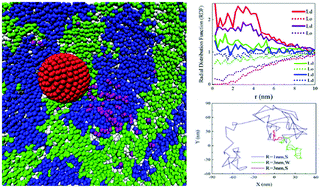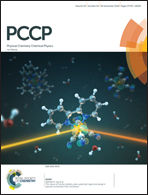Partitioning of nanoscale particles on a heterogeneous multicomponent lipid bilayer†
Abstract
Cell membrane-based sorting and trafficking of nanoscale particles (NPs) are fundamental processes in many cellular activities such as endocytosis, signaling and virus infection; however, the regulation mechanism of these behaviors is still poorly understood. In this work, partitioning of NPs into different lipid phases (i.e., liquid-ordered and liquid-disordered phases) on a ternary lipid bilayer, as well as the influence of NP perturbations on the phase separation of the bilayer, is investigated by using coarse-grained molecular dynamics simulations. Interestingly, it is revealed by our simulations that even with the same chemical affinity between the NPs and lipids in different phases, NPs are still able to preferentially locate at the liquid-disordered (Ld) phase domains. The preferential partitioning behavior of NPs is associated with the physical properties of both the membrane and NPs (e.g., the membrane stiffness and the NP size/quantity). Additionally, the preferential partitioning of NPs facilitates growth of the Ld domain and promotes coupling of this domain between the two leaflets. This work provides new insights into the complicated nano–bio interaction mechanism. Moreover, it suggests methods to regulate the mobility of NPs on cellular membranes to modulate important biological processes accordingly.



 Please wait while we load your content...
Please wait while we load your content...